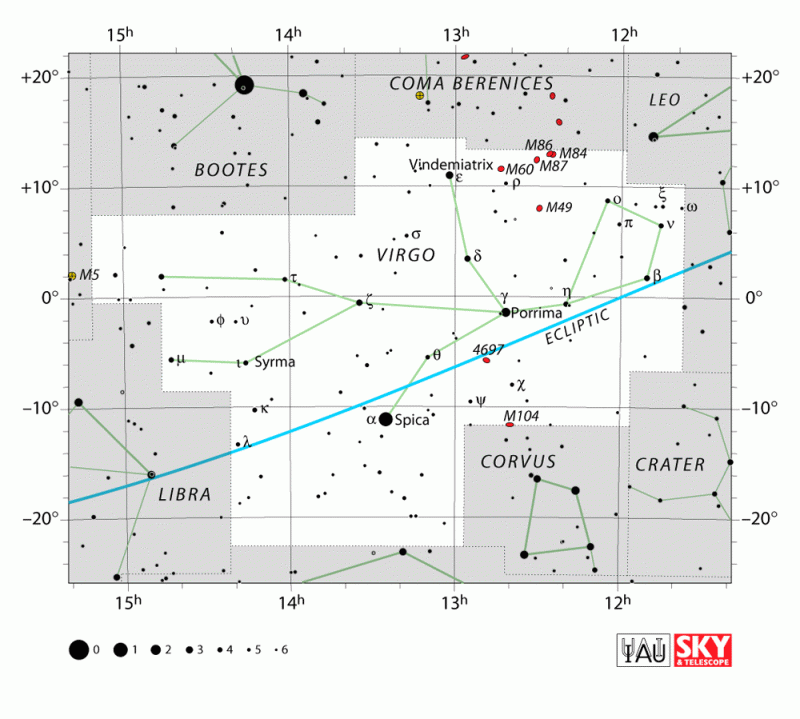On April 27 and 28, 2018, you’ll find the moon in front of the constellation Virgo and close to Spica, Virgo’s brightest star. Spica serves as a prime example of a 1st-magnitude star; in other words, it’s one of the brightest stars in our sky. You’ll have no trouble picking it out, even in the glare of the waxing gibbous moon, over these next few nights.
Keep watching, and try to recognize patterns of stars around Spica if you can. If you do, once the moon leaves the evening sky in another week or two, you’ll easily note this star’s color. Spica is a blue-white gem of a star, and, for stars, color reveals temperature. Spica’s blue-white complexion shows that its surface temperature is extremely high (39,860 degrees Fahrenheit, or 22,127 degrees Celsius). In contrast, our yellow-colored sun has a much cooler surface (only 9,980 degrees F, or 5,527 degrees C). The surface temperature of a red star, such as Antares, is even cooler (5,840 degrees F, or 3,227 degrees C).

Color/temperature chart via Wikipedia
Spica lies nearly on the ecliptic, the annual pathway of the sun in front of the background stars. If you could see stars during the day, you’d see the sun in front of Virgo from approximately September 16 to October 31 each year.
The moon (more or less) follows the ecliptic as well, and thus – as the moon makes its monthly rounds in front of the constellations of zodiac – it spends several days of each month in front of Virgo, routinely passing near Spica.

Virgo constellation chart via the International Astronomical Union (IAU)
But the moon’s motion along the ecliptic is not so steadfast as that of the sun. The moon undergoes an 18.6-year cycle, whereby the moon – as it passes Spica – can swing anywhere from 5 degrees (10 moon-diameters) to the north of the ecliptic to 5 degrees (10 moon-diameters) south of the ecliptic.
Since Spica lies 2 degrees (4 moon-diameters) south of the ecliptic, that means the moon has periods when it occults (passes in front of) this star. The next occultation series of Spica will start on June 16, 2024, and will conclude on November 17, 2025, featuring a total of 20 occultations.
Keep watching the moon over the nights following April 27 and 28. As it moves in orbit, it’ll be edging closer to an even brighter object than Spica in our sky – not another star – but a bright planet, Jupiter. Check out the chart below, and enjoy moon watching!

In late April 2018, watch the waxing gibbous moon travel away from the star Spica and toward the dazzling planet Jupiter.
Bottom line: April 27 and 28 find the moon in front of the constellation Virgo and close to Spica, Virgo’s brightest star.
from EarthSky https://ift.tt/2KjVoBg
On April 27 and 28, 2018, you’ll find the moon in front of the constellation Virgo and close to Spica, Virgo’s brightest star. Spica serves as a prime example of a 1st-magnitude star; in other words, it’s one of the brightest stars in our sky. You’ll have no trouble picking it out, even in the glare of the waxing gibbous moon, over these next few nights.
Keep watching, and try to recognize patterns of stars around Spica if you can. If you do, once the moon leaves the evening sky in another week or two, you’ll easily note this star’s color. Spica is a blue-white gem of a star, and, for stars, color reveals temperature. Spica’s blue-white complexion shows that its surface temperature is extremely high (39,860 degrees Fahrenheit, or 22,127 degrees Celsius). In contrast, our yellow-colored sun has a much cooler surface (only 9,980 degrees F, or 5,527 degrees C). The surface temperature of a red star, such as Antares, is even cooler (5,840 degrees F, or 3,227 degrees C).

Color/temperature chart via Wikipedia
Spica lies nearly on the ecliptic, the annual pathway of the sun in front of the background stars. If you could see stars during the day, you’d see the sun in front of Virgo from approximately September 16 to October 31 each year.
The moon (more or less) follows the ecliptic as well, and thus – as the moon makes its monthly rounds in front of the constellations of zodiac – it spends several days of each month in front of Virgo, routinely passing near Spica.

Virgo constellation chart via the International Astronomical Union (IAU)
But the moon’s motion along the ecliptic is not so steadfast as that of the sun. The moon undergoes an 18.6-year cycle, whereby the moon – as it passes Spica – can swing anywhere from 5 degrees (10 moon-diameters) to the north of the ecliptic to 5 degrees (10 moon-diameters) south of the ecliptic.
Since Spica lies 2 degrees (4 moon-diameters) south of the ecliptic, that means the moon has periods when it occults (passes in front of) this star. The next occultation series of Spica will start on June 16, 2024, and will conclude on November 17, 2025, featuring a total of 20 occultations.
Keep watching the moon over the nights following April 27 and 28. As it moves in orbit, it’ll be edging closer to an even brighter object than Spica in our sky – not another star – but a bright planet, Jupiter. Check out the chart below, and enjoy moon watching!

In late April 2018, watch the waxing gibbous moon travel away from the star Spica and toward the dazzling planet Jupiter.
Bottom line: April 27 and 28 find the moon in front of the constellation Virgo and close to Spica, Virgo’s brightest star.
from EarthSky https://ift.tt/2KjVoBg

Aucun commentaire:
Enregistrer un commentaire